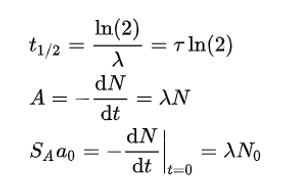<A>
chemical elements (volatilizing): *
The chemical language used to show the transmutation of nitrogen into oxygen, using alpha particles directed at nitrogen is: 14N + α → 17O + p.
The diagram below shows the transmutation of gold into lead through 10 steps or transmutations:
197Au + n → 198Au (half-life 2.7 days) → 198Hg + n → 199Hg + n → 200Hg + n → 201Hg + n → 202Hg + n → 203Hg (half-life 47 days)→ 203Tl + n → 204Tl (half-life 3.8 years) → 204Pb
<B>
dynamics of matter…aether: *
Spengler’s use of the word “aether” as late as 1922 appears atavistic. By 1905 Einstein had delivered the coup de grace to “aether”; his theories of relativity & light wave/particle meant no aether was now needed. Despite this Einstein himself continued to use the term. In his correspondence of 1916 he refers to the “new aether” & in 1918 he publicly alluded to this new definition. In the early 1920s Einstein tried to reconcile relativity with Lorentzian aether concluding that special relativity does not necessarily rule out the aether. He issued similar statements in 1924 & 1930. Nevertheless his use of the word "aether" found little support in the scientific community & played no role in the continuing development of modern physics.
<C>
epistemology (latest): *
Unfortunately Spengler provides no specific references to allow the reader to identify the particular school or person whom he is referring to. His “last discussions of epistemology” may have been based on papers written in the pre-war period (1900-1914). In 1900 the philosophy of science & epistemology was dominated by the concept of Instrumentalism. This notion posits that successful scientific theory reveals nothing known about nature's unobservable objects, it is merely a tool to predict observations in a particular domain. It rejects ambitions to uncover metaphysical truths of Nature. This perspective was introduced by Pierre Duhem in 1906.
Duhem (1861-1916) was a French theoretical physicist who worked on thermodynamics, hydrodynamics & elasticity; he was also a historian of science, noted for his work on the European Middle Ages. He published from 1886 to 1916, well within the time frame of Spengler’s intellectual ken. Duhem is linked to “the Duhem–Quine thesis” which refers to the indeterminacy of experimental criteria. This leads to the epistemological problem of “the indeterminacy of data to theory” or underdetermination, which claims that since any dataset can be consistent with several different explanations, the success of any given prediction does not confirm the truth of the theory. There are always several different ways to interpret evidence, not a single high road or main path. Goethe argued in a similar vein in his critique of Newton’s colour theory. All the evidence Newton used to support his theory of colours was also used by Goethe to support his theory. Duhem explicitly referred to Physics stating no single hypothesis can be isolated for testing, since Physics rests on a foundation of assumptions. Furthermore he excludes logic & mathematics from physics as they cannot be tested. Mathematical models may represent something but this is not the same as explaining it. Physics is not identical to mathematics. His respect for the continuity of science meant he was adverse to new radical theories. Duhem believes meant he devalued many early 20th century scientific discoveries. He was unconvinced about the reality & the usefulness of atoms. He did not accept the statistical mechanics of Maxwell, Boltzmann & Gibbs in explaining thermodynamics. He opposed Einstein's theory of relativity, arguing it turned physics into chaos, lacking logic or common sense. Much of his criticism was based on Relativity’s lack of continuity with Classical Physics.
Duhem was also a historian of science (The System of World: A History of Cosmological Doctrines from Plato to Copernicus, 10 volumes, 1913). Duhem regarded Medieval scientists with considerable respect, reversing the Enlightenment attitude. He also proposed continuity between Medieval science & modern science, another idea rejected by the 18th century.
Spengler & Duhem
All the above notions, Instrumentalism, underdetermination, the Duhem–Quine thesis, the continuity of Western science, sit favourably with Spengler. Many of Duhem’s ideas resonate throughout Decline. Spengler is a scientific agnostic, Faustian Science is no more true than Apollonian, a relativist attitude which reflects underdetermination. Spengler fully agrees with Duhem in the continuity of science between the Middle & Modern ages, an idea he returns to many times. Spengler was also dismissive of Relativity (he refers to it as a “ruthlessly cynical hypothesis”) which may well reflect Duhem. His somewhat sceptical attitude regarding atoms may likewise reflect the Frenchman’s bias. Finally he may have consulted Duhem for his studies of Medieval science, but as Decline has no bibliography, we cannot know for sure.
<D>
sign-language (of the emanation-theory of radioactivity): *
The decay rate, or activity, of a radioactive substance is characterized by:
CONSTANTS
The half-life— t1/2- the time taken for the activity of a given amount of a radioactive substance to decay to half of its initial value.
The decay constant— λ, "lambda" the reciprocal of the mean lifetime (in s−1), sometimes referred to as simply decay rate.
The mean lifetime— τ, "tau" the average lifetime (1/e life) of a radioactive particle before decay.
TIME-VARIABLE QUANTITIES
Total activity— A, is the number of decays per unit time of a radioactive sample.
Number of particles—N, is the total number of particles in the sample; where N0 is the initial amount of active substance — substance that has the same percentage of unstable particles as when the substance was formed.
Specific activity—SA, number of decays per unit time per amount of substance of the sample at time set to zero (t = 0). "Amount of substance" can be the mass, volume or moles of the initial sample.
The above CONSTANTS & TIME-VARIABLE QUANTITES are related as follows:

where No is the initial amount of active substance — substance that has the same percentage of unstable particles as when the substance was formed.
<E>
potency: * see Endnote<E>
The elements of a powerset — ℘({a, b, c}) ordered with respect to inclusion.
below lattice diagram for ℘
